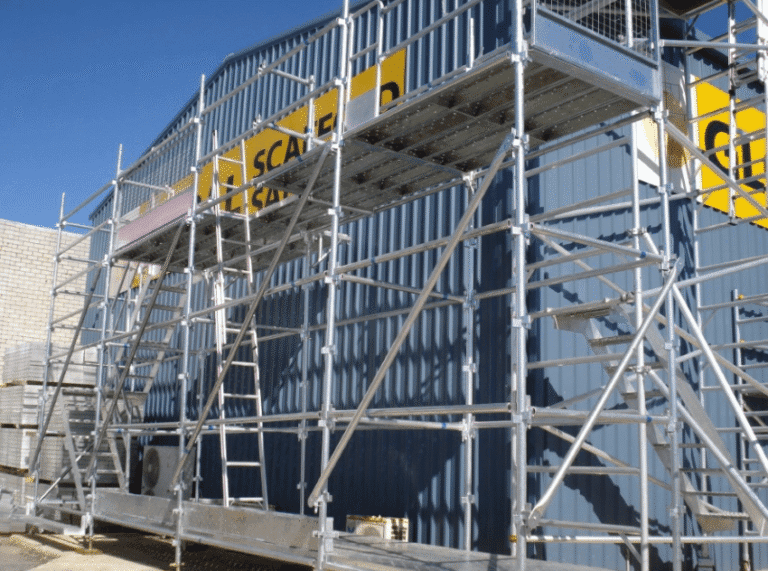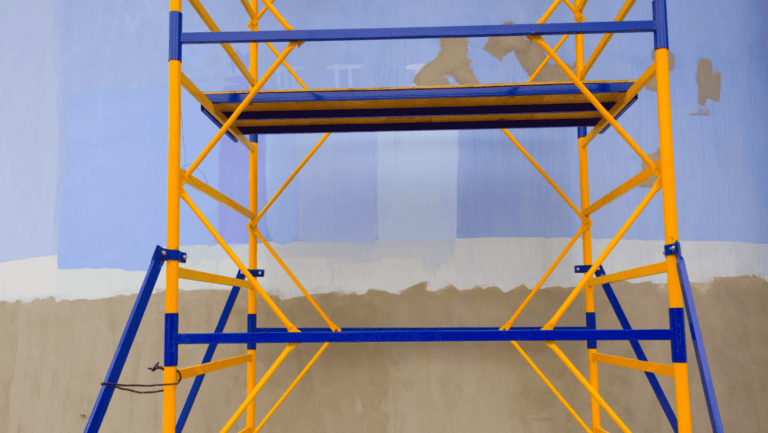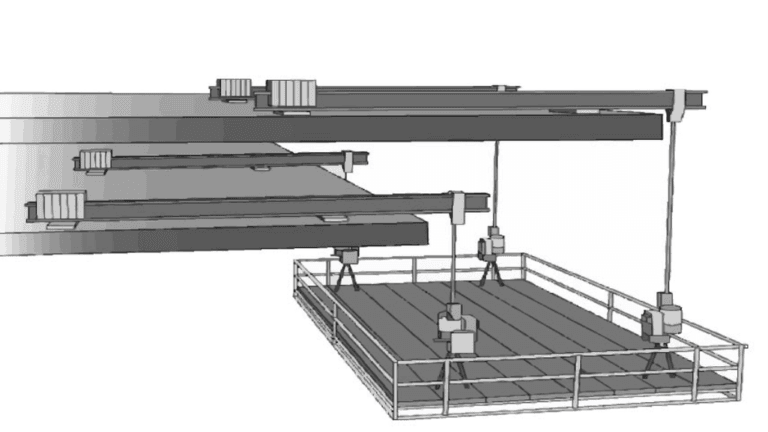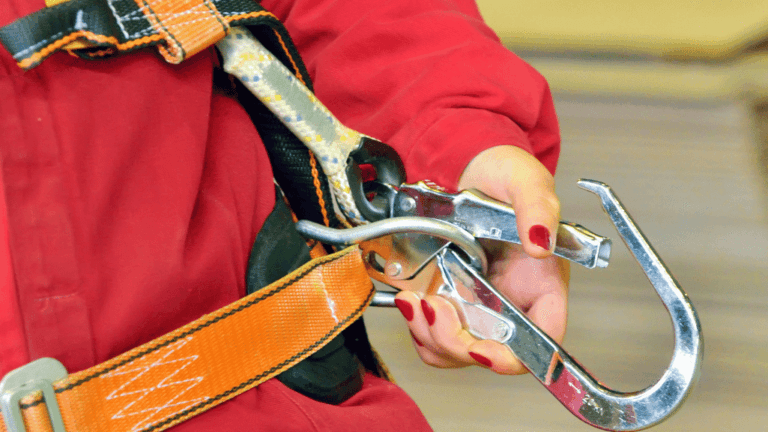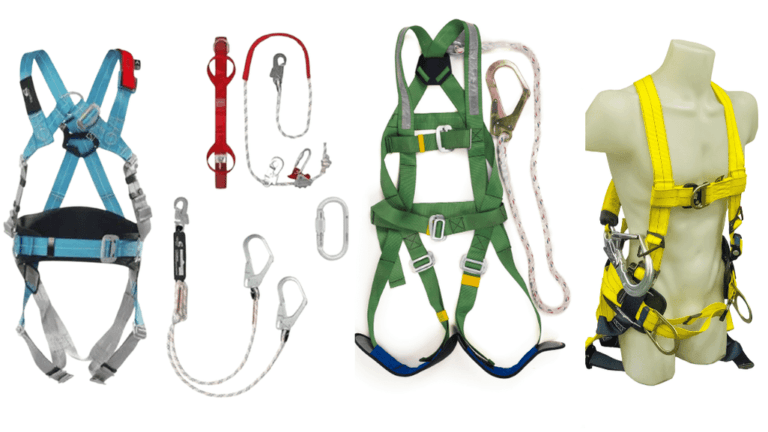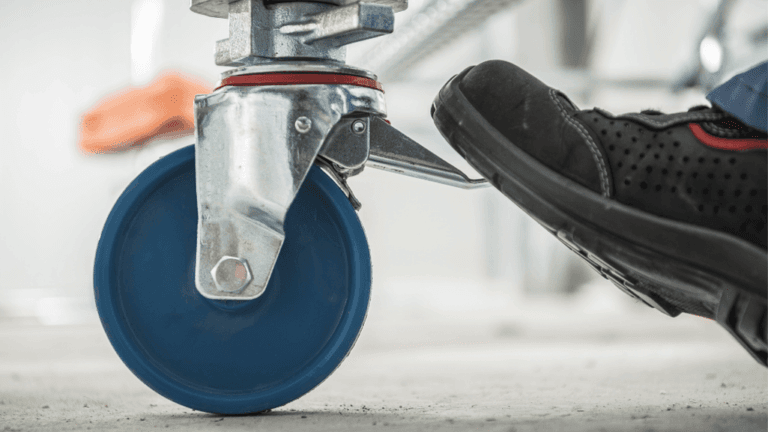Phone:
(+65)8319-0742
Scaffolding caster wheels are an essential element of any scaffolding structure. They provide mobility and ensure the safety of workers on construction sites. Choosing the right scaffolding wheels is crucial in maintaining stability and ease of use of the scaffolding system.
Key Takeaways:
- Choosing the right scaffolding wheels is vital for mobility and safety on construction sites.
- Scaffolding caster wheels enable easy movement and provide stability for the scaffold structure.
- Factors such as size, material, and load-bearing capacity should be considered when selecting scaffold wheels.
- Proper installation and maintenance of scaffold casters help ensure their effectiveness and longevity.
- Contact AAIT, a reputable scaffolding company, for expert advice and estimation for scaffold casters.
What are Caster Wheels?
Caster wheels are an essential component of scaffolding equipment, enabling easy movement and mobility of scaffolding structures on worksites. These unpowered wheels are attached to the underside of larger objects, such as scaffolding, to facilitate their transportation. The use of caster wheels allows scaffolding to be effortlessly maneuvered, saving time and effort for workers.
Unlike fixed wheels, caster wheels are designed to rotate 360 degrees, enabling seamless movement in any direction. This feature is particularly advantageous when working on large construction projects that require frequent relocation of scaffolding. By providing enhanced mobility, caster wheels enable construction workers to access different areas of the worksite efficiently.
Whether it’s moving scaffolding from one area to another or adjusting its position for better accessibility, caster wheels play a crucial role in ensuring the smooth operation of construction projects. They offer flexibility and versatility, allowing contractors to optimize their workflow and speed up the completion of tasks.
Selection Criteria for Scaffold Casters
When choosing the right scaffold casters for your project, it is important to consider several key criteria to ensure optimal performance and safety. The following factors should be taken into account:
- Size: Determine the appropriate size of the casters based on the specific requirements of your scaffolding. Consider the available space and the desired level of maneuverability.
- Material: Select casters made of high-quality materials that can withstand the demands of construction sites. Common options include rubber, polyurethane, plastic, nylon, and steel.
- Load-Bearing Capacity: Evaluate the maximum load-bearing mass of the casters to ensure they can safely support the weight of the scaffolding structure and any additional load it may carry.
- Bracket: Assess the type of bracket used in the casters. Different brackets offer varying degrees of stability and ease of installation.
- Installation: Consider the method of installation for the scaffold casters. Ensure that the chosen casters can be easily installed on your scaffolding system without compromising its integrity.
- Breaking and Locking Mechanism: Examine the breaking and locking mechanism of the casters to guarantee secure positioning and prevent unintentional movement.
By carefully evaluating these selection criteria, you can make an informed decision and choose scaffold casters that align with your project’s specific needs and requirements.
Benefits of Scaffold Casters
Scaffold casters offer several benefits that contribute to the efficiency and safety of scaffolding structures. These casters are specifically designed to enhance mobility, ensure stability, and provide reliable load-bearing capacity.
Enhanced Mobility
Scaffold casters play a vital role in improving the mobility of scaffolding systems. With the ability to easily move scaffolding to different areas of a worksite, tradesmen and workers can efficiently carry out their tasks without the need for disassembly and reassembly at every location.
A well-designed scaffold caster system allows for smooth and effortless movement, enabling workers to navigate around obstacles, tight spaces, or changes in elevation. This flexibility saves time and effort, improving overall productivity on the job site.
Increased Safety
The safety of scaffolding structures is of paramount importance, and scaffold casters contribute significantly to ensuring a secure and stable setup. These casters are equipped with features such as swivel mechanisms and efficient braking systems that prevent unintentional movement and provide stability during work.
By securely locking the casters in place, workers can focus on their tasks without worrying about the scaffold shifting or moving unexpectedly. This not only reduces the risk of falls and accidents but also boosts confidence and productivity.
High Load-Bearing Capacity
When working with heavy loads on scaffolding, the load-bearing capacity of the casters is crucial. Scaffold casters are designed to withstand substantial weight without compromising their performance or safety. This allows workers to confidently transport materials, tools, and equipment on the scaffolding without concerns about the casters breaking or failing.
In conclusion, scaffold casters provide enhanced mobility, improved safety, and high load-bearing capacity, making them an essential component of any scaffolding system. By selecting the right casters and ensuring regular maintenance, construction professionals can optimize the efficiency and safety of their scaffolding operations.
Scaffold Caster Installation and Safety Measures
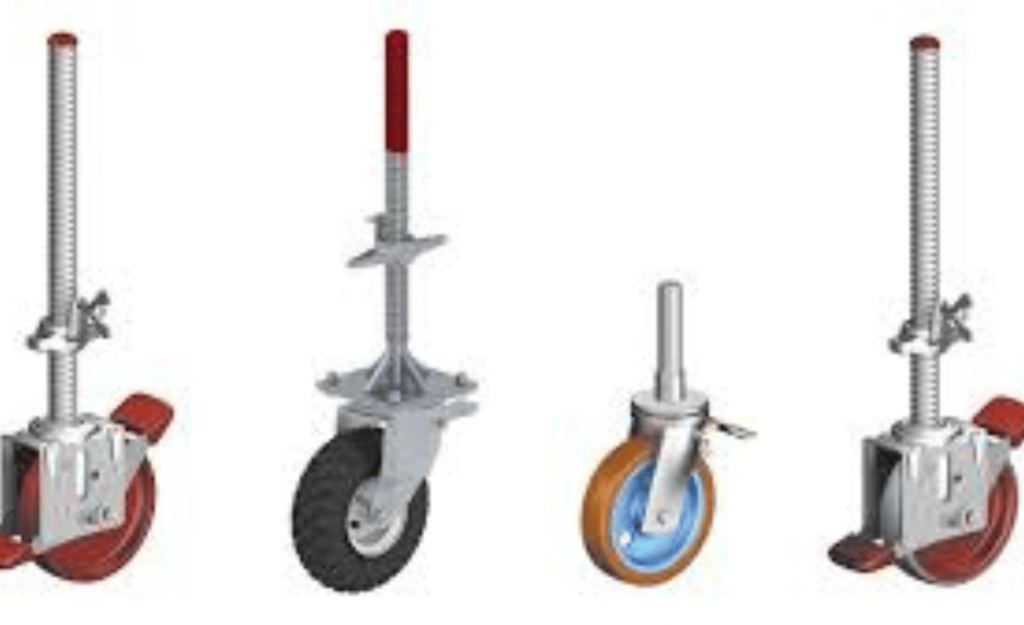
Proper installation of scaffold casters is crucial for their effectiveness and overall safety of the scaffolding structure. When installing scaffold casters, it is essential to follow specific guidelines and safety measures to ensure optimal performance. Here are some key considerations:
- Selection based on flooring conditions: Choose scaffold casters that are suitable for the type of flooring on the worksite. Different flooring materials may require specific caster types or materials to avoid damage or instability.
- Install before the rest of the structure: It is best to install the casters before constructing the scaffolding platform. This allows for easier maneuverability and eliminates the need to lift the entire structure to add the casters later on.
- Test for smooth rolling and braking: Before putting the scaffold into use, ensure that the casters roll smoothly and brake effectively. This testing phase helps identify any issues or defects in the casters, ensuring safe and reliable mobility.
Additionally, implementing proper safety measures is vital to prevent accidents and mishaps when using scaffold casters:
- Avoid overloading the scaffolding: Adhere to the load-bearing capacity specified by the manufacturer. Overloading the scaffolding can put excessive strain on the casters, compromising their stability and safety.
- Avoid dropping heavy loads on the casters: Placing heavy loads directly on the scaffold casters can cause damage and affect their functionality. Take care to distribute weight evenly and utilize the scaffold platform to support heavy objects.
- Always lock the casters in place: Locking the casters prevents unwanted movement or rolling during work. Ensure that the locking mechanism is engaged securely before ascending or using the scaffold.
By following the proper installation procedures and adhering to safety measures, the scaffold casters can provide reliable mobility and contribute to a safe working environment.
Related Safety Quote:
“Safety first is safety always.” – Charles M. Hayes, American Labor Leader
| Scaffold Caster Installation Checklist |
|---|
| 1. Select appropriate casters for the flooring conditions. |
| 2. Install the casters before constructing the scaffold. |
| 3. Test the casters for smooth rolling and braking. |
| 4. Avoid overloading the scaffolding. |
| 5. Avoid dropping heavy loads on the casters. |
| 6. Always lock the casters in place. |
Scaffold Caster Wheel Materials
When it comes to scaffold caster wheels, selecting the right material is crucial for optimal performance and floor protection. Various materials are used in the construction of scaffold caster wheels, each offering unique advantages and suitability for different ground conditions.
Common materials used in scaffold caster wheels include:
- Super Synthetic Rubber: Known for its excellent grip and shock-absorbing properties, super synthetic rubber caster wheels provide increased traction and stability on a variety of surfaces.
- Polyurethane: Polyurethane wheels are highly durable and resistant to wear, making them ideal for heavy-duty applications. They offer smooth and quiet operation and can withstand heavy loads without compromising performance.
- Plastic: Plastic scaffold caster wheels are lightweight, affordable, and resistant to corrosion. They are suitable for lighter applications and indoor use where noise reduction is a concern. However, they may not offer the same level of durability as other materials.
- Nylon: Nylon wheels are renowned for their strength, durability, and resistance to impact. They are ideal for rugged environments and can handle heavy loads with ease.
- Steel: Steel scaffold caster wheels provide exceptional strength and durability, making them suitable for heavy-duty applications and rough terrain. They are corrosion-resistant and can withstand harsh conditions.
- High-Temperature Materials: Scaffold caster wheels made from high-temperature materials are designed to withstand extreme temperatures without compromising performance. These wheels are ideal for applications where heat resistance is essential.
- Rubber: Rubber scaffold caster wheels offer a balance between grip, durability, and noise reduction. They provide good traction on various surfaces and are often used in indoor and outdoor settings.
The selection of the appropriate scaffold caster wheel material depends on the specific application requirements and the desired level of floor protection. Factors such as surface type, load-bearing capacity, and environmental conditions should be considered when choosing the optimal material for scaffold caster wheels.
| Material | Advantages | Suitability |
|---|---|---|
| Super Synthetic Rubber | Excellent grip and shock absorption | Versatile, suitable for various surfaces |
| Polyurethane | Durable, resistant to wear | Heavy-duty applications, smooth operation |
| Plastic | Lightweight, affordable | Lighter applications, indoor use |
| Nylon | Strong, impact-resistant | Rugged environments, heavy loads |
| Steel | Exceptional strength, durability | Heavy-duty applications, rough terrain |
| High-Temperature Materials | Heat-resistant, withstand extreme temperatures | Applications with high heat exposure |
| Rubber | Balanced grip, durability, and noise reduction | Indoor and outdoor use |
Scaffolding Caster Features and Mechanisms
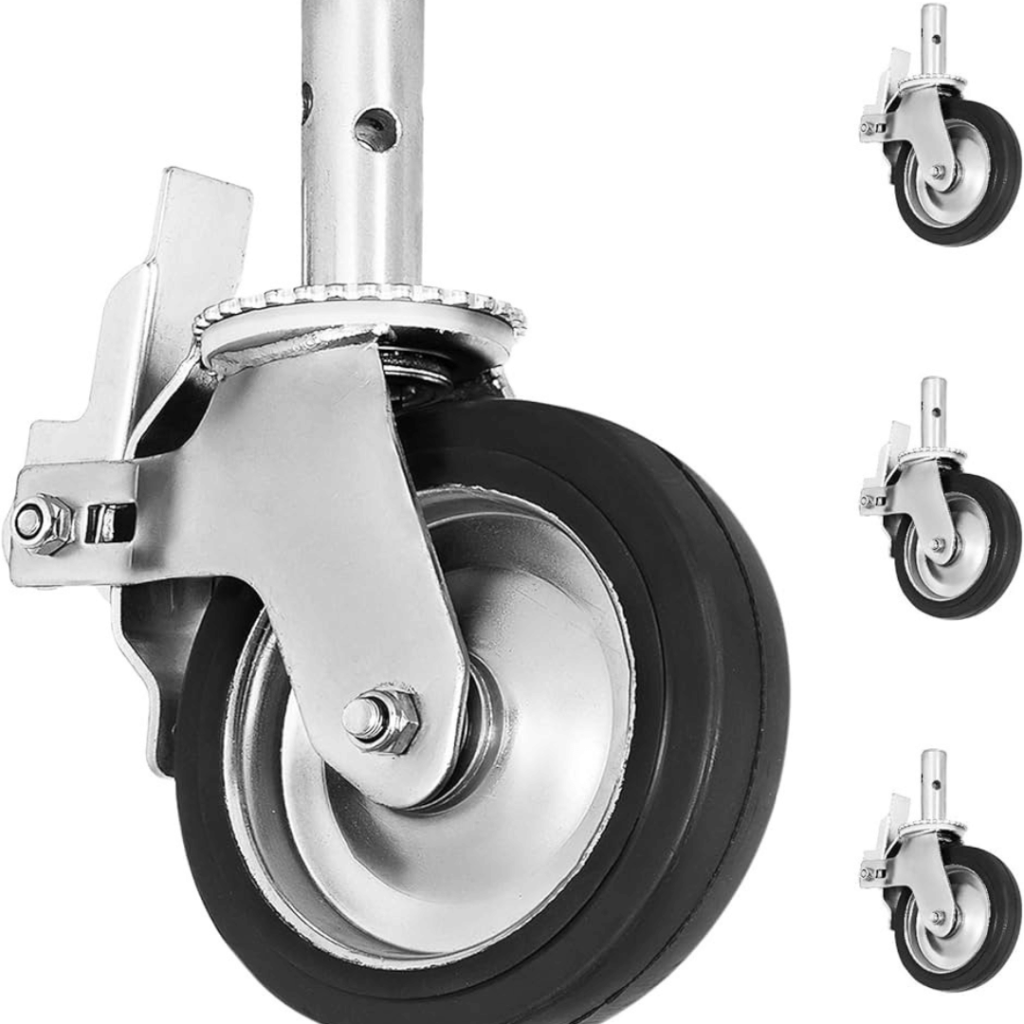
Scaffolding casters are designed with specific features and mechanisms to enhance their performance in scaffolding applications. These features ensure easy maneuverability, stability, and the ability to bear heavy loads. Let’s explore the key features and mechanisms of scaffolding casters:
1. Swivel Mechanism
The swivel mechanism allows the caster to rotate 360 degrees, enabling easy movement and maneuverability of the scaffolding. This feature is essential when navigating confined spaces or tight corners on the worksite.
2. Braking and Locking Mechanisms
Efficient braking and locking mechanisms provide stability and safety during scaffolding work. These mechanisms ensure that the casters remain fixed in place when the scaffolding is in use, preventing accidental movement and potential accidents.
3. Load-Bearing Capacity
Scaffolding casters are designed to bear heavy loads, including the weight of multiple workers and equipment. The load-bearing capacity is a crucial feature to consider when selecting casters for scaffolding, as it determines the overall stability and safety of the structure.
Image: Scaffolding casters in action, showcasing their load-bearing capacity.
In conclusion, scaffolding casters come with features such as a swivel mechanism for easy maneuverability, efficient braking and locking mechanisms for stability, and a high load-bearing capacity. These features make them ideal for scaffolding applications, ensuring mobility and safety on construction sites.
Scaffolding Caster Installation Tips
Proper installation of scaffold casters is crucial for the smooth operation and safety of your scaffolding. Follow these tips to ensure a hassle-free installation process:
- Select appropriate casters: Consider the flooring conditions of your worksite and choose casters that are suitable for the terrain. Factors like the type of flooring material, smoothness, and stability should be taken into account when making your selection.
- Install before the rest of the structure: To prevent any inconvenience or interference during the installation process, it is recommended to attach the casters to the scaffolding before adding other components. This will make it easier to maneuver the scaffolding into position.
- Test functionality: Once the casters are installed, test their functionality before fully utilizing the scaffolding. Check if they roll smoothly and ensure that the breaking and locking mechanisms are working correctly. This step is crucial to guarantee the safety of both workers and the structure itself.
By following these scaffolding caster installation tips, you can ensure that your scaffolding is safe, stable, and easy to move. Proper installation is essential for the efficiency and success of your construction projects.
Expert Tip:
Always refer to the manufacturer’s instructions for specific installation guidelines and recommended practices. They will provide valuable insights on the proper installation of the casters for your particular scaffolding model.
Scaffold Caster Maintenance
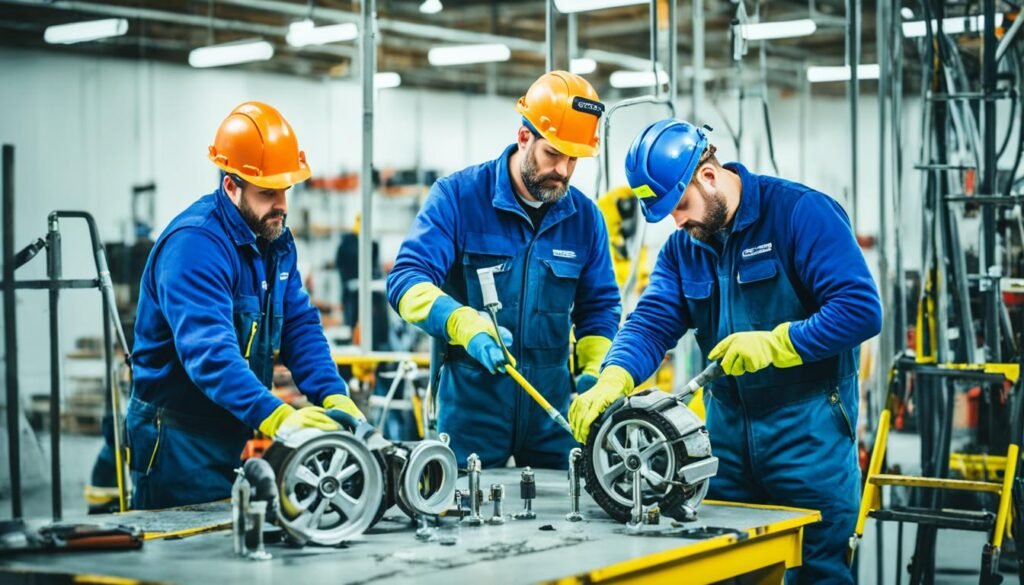
Routine maintenance is essential for ensuring the longevity and optimal performance of scaffold casters. By regularly inspecting and maintaining these crucial components, you can enhance their durability and maximize their functionality. Here are some key maintenance tasks that should be performed:
1. Regular Inspections
Inspecting scaffold casters on a regular basis helps identify any signs of wear and tear, damage, or loose components. Look for cracks, rust, or deformation in the caster wheels, as well as any loose bolts or brackets. Addressing these issues promptly can prevent further damage and ensure the safe operation of the scaffolding.
2. Greasing of Ball Bearings
Ball bearings play a vital role in the smooth rolling and maneuverability of scaffold casters. Greasing these bearings at regular intervals helps reduce friction, minimize wear, and extend their lifespan. Refer to the manufacturer’s guidelines or consult a professional to determine the appropriate type and frequency of lubrication.
3. Tightening of Loose Components
Over time, the vibration and movement associated with scaffolding can cause bolts, nuts, and other components to become loose. Regularly inspect and tighten all fasteners to ensure the stability and integrity of the scaffold casters. Use appropriate tools and follow recommended torque specifications to prevent overtightening or damage.
4. Cleaning and Removal of Debris
Keep your scaffold casters clean and free from debris, such as dirt, mud, or construction materials. Regularly wipe them down and remove any accumulated debris that could hinder their movement or cause damage. Pay special attention to the axles, brakes, and swivel mechanisms, ensuring they remain clean and functional.
“Proper maintenance of scaffold casters is crucial for the safety and efficiency of scaffolding operations. By investing time and effort into routine inspections and maintenance tasks, you can reduce the risk of accidents, prevent costly repairs, and prolong the lifespan of your scaffold casters.”
By following these maintenance practices, you can ensure the reliability and performance of your scaffold casters, ultimately contributing to a safer and more productive worksite.
| Maintenance Task | Description |
|---|---|
| Regular Inspections | Inspect scaffold casters for signs of damage, wear, and loose components. |
| Greasing of Ball Bearings | Apply appropriate lubrication to reduce friction and extend the lifespan of ball bearings. |
| Tightening of Loose Components | Regularly inspect and tighten bolts, nuts, and other fasteners to ensure stability. |
| Cleaning and Removal of Debris | Keep scaffold casters clean and free from debris that could hinder their movement. |
Conclusion
In conclusion, the selection of the right scaffolding wheels or casters is crucial for ensuring the mobility and safety of construction projects. When choosing scaffolding wheels or casters, factors such as size, material, load-bearing capacity, and installation method should be carefully considered. By selecting the appropriate wheels or casters, construction workers can enhance the mobility and maneuverability of the scaffolding, allowing them to easily navigate different areas of the worksite.
Furthermore, the safety of the scaffolding structure is greatly influenced by the quality and reliability of the wheels or casters. Sturdy and well-designed scaffold wheels or casters contribute to the stability of the scaffolding, preventing unintended movement and ensuring the safety of workers who use the scaffolding.
Proper maintenance is also vital for maximizing the longevity and performance of scaffolding wheels or casters. Regular inspections, greasing of ball bearings, and tightening of loose components are necessary maintenance tasks to preserve the optimal functionality of the wheels or casters over time.
By considering these factors and implementing the necessary maintenance practices, construction professionals can ensure that their scaffolding is equipped with high-quality wheels or casters that offer optimal mobility, safety, and load-bearing capacity.
Request Your Estimation Today
If you are in need of scaffolding wheels or casters, don’t hesitate to contact AAIT, a reputable scaffolding company in Houston. With their wide range of scaffold caster options and expertise in the field, AAIT can provide expert advice and solutions tailored to your specific scaffolding needs. Reach out to them today to request your estimation and take a step towards enhancing the mobility and safety of your construction projects.
Additional Resources for Scaffold Casters
For additional information on scaffold casters and related products, consider exploring scaffold wheel accessories and scaffold wheel replacement parts. These resources can provide further guidance and support in selecting and maintaining scaffold casters.
When it comes to scaffold casters, having access to additional resources can be invaluable. Whether you’re looking for scaffold wheel accessories to enhance the functionality of your casters or scaffold wheel replacement parts to ensure their longevity, these resources can help you make informed decisions.
Why Choose Scaffold Wheel Accessories?
Scaffold wheel accessories are designed to optimize the performance of your scaffold casters. They offer a range of features and options that can enhance mobility, ease of use, and overall stability. Some popular scaffold wheel accessories include:
- Locking mechanisms for added safety and security
- Brake systems to prevent unwanted movement
- Swivel mechanisms for improved maneuverability
- Adjustable height options for varying worksite conditions
By investing in scaffold wheel accessories, you can customize your casters to meet your specific needs, ensuring that your scaffolding operates smoothly and safely.
Benefits of Scaffold Wheel Replacement Parts
Over time, scaffold casters may experience wear and tear, requiring replacement parts to maintain their functionality. Scaffold wheel replacement parts offer the following benefits:
- Improved performance: Replacing worn-out wheels can restore the mobility and maneuverability of your scaffolding.
- Cost-effectiveness: Instead of replacing entire caster assemblies, replacing individual parts can be a more affordable solution.
- Extended lifespan: By replacing damaged or worn-out parts, you can prolong the overall lifespan of your scaffold casters.
Whether you need replacement wheels, axles, or bearings, scaffold wheel replacement parts can help you keep your casters in optimal working condition.
Request Your Estimation Today
Looking for high-quality scaffold casters for your construction project? Look no further than AAIT, a trusted scaffolding company based in Houston. With years of expertise in the industry, AAIT offers a wide range of scaffold caster options to suit your specific needs.
Whether you require scaffold casters for a small-scale renovation or a large-scale construction project, AAIT has got you covered. Their team of knowledgeable professionals can provide expert advice and solutions to help you choose the right caster wheels for your scaffolding.
When you choose AAIT for your scaffold caster needs, you can expect exceptional quality, durability, and performance. Their casters are designed to withstand heavy loads and ensure the mobility and safety of your scaffolding structure.
Don’t settle for subpar scaffold casters. Reach out to AAIT today to request your estimation. Take advantage of their extensive product range and let their experienced team assist you in finding the perfect scaffold caster solution for your project. Contact AAIT now for top-notch scaffold casters that meet your requirements.
FAQ
What are caster wheels?
Caster wheels are unpowered wheels that are attached to the underside of larger objects to facilitate their movement. In the case of scaffolding, caster wheels are attached to the bottom of the scaffolding to allow it to be easily moved around the worksite. They are an essential part of the scaffolding equipment.
What are the selection criteria for scaffold casters?
When selecting scaffold casters, several criteria should be considered. These include the size of the caster, the material it is made of, the load-bearing capacity, the type of bracket, the method of installation, and the breaking and locking mechanism. Each of these factors plays a role in determining the suitability of a caster for a specific scaffolding application.
What are the benefits of scaffold casters?
Scaffold casters offer several benefits. They enhance the mobility of the scaffolding, allowing tradesmen and workers to move it easily to different areas. They also contribute to the safety of the scaffolding by providing stability and preventing unintentional movement. Additionally, scaffold casters have high load-bearing capacity, allowing them to support heavy weights without breaking.
How should scaffold casters be installed and what safety measures should be taken?
Proper installation of scaffold casters is essential to ensure their effectiveness and the overall safety of the scaffolding. The casters should be selected based on the flooring conditions, installed before the rest of the structure, and tested for smooth rolling and braking. Safety measures, such as avoiding overloading the scaffolding, not dropping heavy loads on the casters, and always locking them in place, are crucial to prevent accidents and mishaps.
What materials are scaffold caster wheels made from?
Scaffold caster wheels are made from various materials, each with its advantages and suitability for different ground conditions. Common materials include super synthetic rubber, polyurethane, plastic, nylon, steel, high-temperature materials, and rubber. The selection of the appropriate material depends on the specific application and the desired floor protection.
What are the features and mechanisms of scaffolding casters?
Scaffolding casters have specific features and mechanisms that make them ideal for scaffolding applications. These include a swivel mechanism for easy maneuverability, efficient braking and locking mechanisms to ensure stability during work, and a load-bearing capacity that can withstand the weight of multiple workers on the scaffolding.
What are some installation tips for scaffold casters?
When installing scaffolding casters, it is important to select the appropriate casters according to the flooring conditions, install them before the rest of the structure, and test their functionality. These installation tips help ensure the smooth operation and safety of the scaffolding.
How should scaffold casters be maintained?
Routine maintenance of scaffold casters is important to ensure their longevity and performance. Regular inspections, greasing of ball bearings, and tightening of loose components are some essential maintenance tasks that should be performed.
Where can I find additional resources for scaffold casters?
For additional information on scaffold casters and related products, consider exploring scaffold wheel accessories and scaffold wheel replacement parts. These resources can provide further guidance and support in selecting and maintaining scaffold casters.
How can I request an estimation for scaffold casters?
To receive an estimation for scaffold casters, you can contact AAIT, a reputable scaffolding company in Houston. They offer a wide range of scaffold caster options and can provide expert advice and solutions for your scaffolding needs. Reach out to them today to request your estimation.


